Access 2007
Setting up Tables and Fields
Introduction
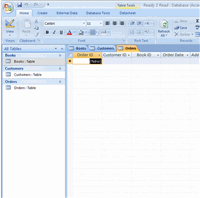 Now that we have a handle on what the database should look like, we need to work on setting up our tables and the fields within those tables.
Now that we have a handle on what the database should look like, we need to work on setting up our tables and the fields within those tables.
In this lesson, we'll walk you through the steps of setting up a database in Access 2007. You will be setting up tables according to the plan for our bookstore scenario. You will also be setting up the fields for each table, including establishing what data types can be entered in a given field.
Setting Up Tables and Fields
Watch the video! (9:23min)
Creating a new database with Access
When you launch Access 2007, you will see the Getting Started window.
In the left pane, the template categories—including the featured local templates—are listed, as well as the categories on Office Online. Templates are prebuilt databases focused on a specific task that you can download and use immediately.
You will also see the New Blank Database option, which allows you to build your own database from scratch.
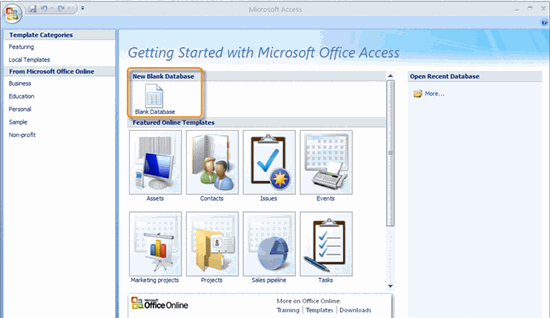 Getting Started Window
Getting Started Window
When you choose the New Blank Database option at the top of the window, you will be prompted to rename the database from the default name, which is Database1.accdb. Rename the database whatever you'd like. In the example below, we named the database Ready2Read since that is the name of the store in our scenario.
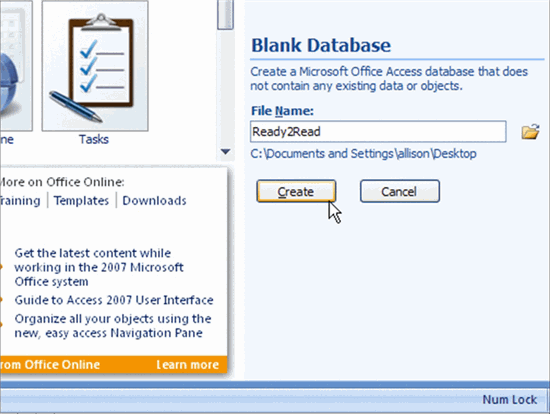 Create a New Blank Database
Create a New Blank Database
Click Create to finish naming the database.
Setting up tables
The new database opens with one table showing as a default. It also defaults to naming this table Table1 in both the Navigation Pane and the Table tab itself. You will want to name your tables based on your database design plan.
 Default Table Name
Default Table Name
Naming a table
To give the table a unique name, you must first click on the Microsoft Office Button in the upper-left corner of the application.
 Naming Table1
Naming Table1
Then, select Save from the menu. The Save As dialog box will appear to let you save the table whatever name you choose.
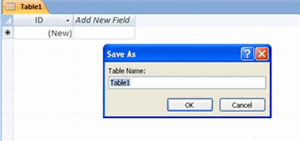 Save As Dialog Box
Save As Dialog Box
The new table names appear in both the Navigation Pane and the Table tab itself, as you can see in the picture below.
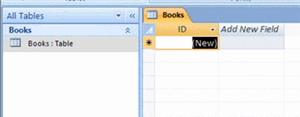 New Table Name
New Table Name
TIP: Give your tables logical, easy-to-understand names.
To rename a table
With the table closed, right click on the Table you wish to rename in the Navigation Pane. Select the Rename option that appears in the menu.
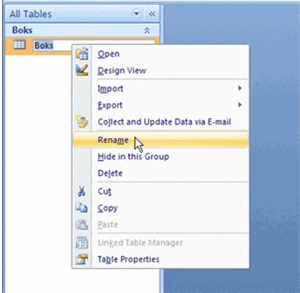 Rename Table from Navigation Pane
Rename Table from Navigation Pane
The table name will be highlighted and a cursor will appear, which means you can now type in the new name right there. Left click anywhere outside of the Table name to make the change.
To close a table
There are several ways to close an active table. You can right click on the Table tab and choose Close from the menu.
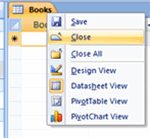 Close Table from Table Tab
Close Table from Table Tab
A more common method is to click the X that appears in the upper-right corner of the active database object window.
 Close Table from Document Window
Close Table from Document Window
To open a table
To open a table, right click the Table name of the table you wish to open in the Navigation Pane. Next, choose Open from the menu.
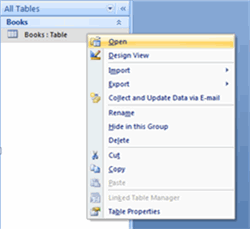 Open Table from Navigation Pane
Open Table from Navigation Pane
A more common method is to double-click the table name in the Navigation Pane. The selected table will open in the active database object window.
Adding more tables to the database
By default, Access 2007 starts out with one table. To add more tables to the database, click on the Create tab on the Ribbon.
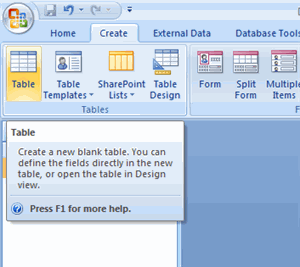 Create New Table
Create New Table
Then, select Table from the Tables command group. A new table will open in the active database object window. You must name your table using the Save command from Microsoft Office menu. Naming a Table was addressed on page 3 of this lesson.
TIP: You can tell which table you are currently in by seeing which table tab is highlighted.
Adding fields to a table
Access 2007 allows you to add fields to tables when you are:
- Working in Datasheet View, which looks like a spreadsheet
- Working in Design View, where you are able to set more controls for your fields
Either way, you need to know how to switch between the two views.
Switching views
To switch views, select the Views command group from either the Home tab (seen below) or the Datasheet tab on the Ribbon. Select the view option you would like from the menu.
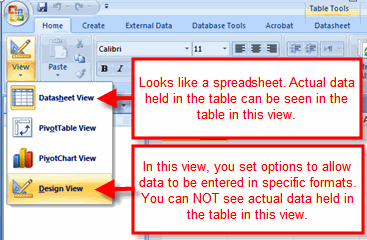 Switching Views
Switching Views
Adding fields in Datasheet View
By default, Access 2007 creates one field in each new table, the ID field. This field auto-numbers to give each record in the table a unique number identifier. Recall that records are the rows in a table.
TIP: You may want to rename the ID field with a unique name, since the ID field appears automatically in every table you create. While this is not necessary, it may help avoid confusion when setting up table relationships.
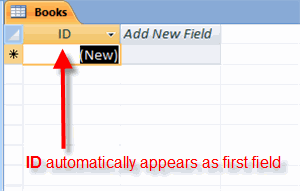 Automatic ID Field
Automatic ID Field
To add more fields to a table in Datasheet View, double-click the Add New Field header.
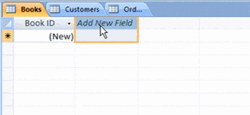 Add New Field
Add New Field
The Add New Field text will disappear from the header. Name the field by typing the name directly into the header. Press the tab key on your keyboard to move to the next field.
Adding fields in Design View
In Design View, the field names are along the left-hand column instead of across the top like in Datasheet View, as seen below.
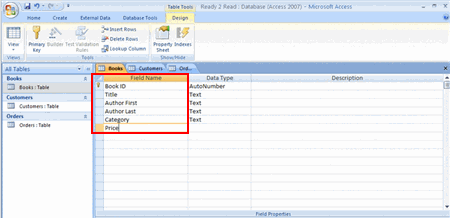 Fields in Design View
Fields in Design View
To add a new field to a table in Design View, just click in the cell where you want the new field and type the field name. When you switch back to Datasheet View, your new field appears as its own column, as seen below.
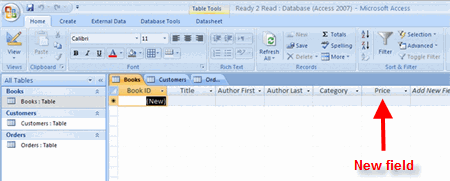 Datasheet View of Added Field
Datasheet View of Added Field
In Design View, you have many field property options you can set to ensure that data can only be entered in certain formats. Setting these options is a good idea if you want to make sure the data you have in your database is good, strong data.
Moving fields
If you want to rearrange the order in which your fields appear in a table, Access 2007 lets you easily move them around. To move a field in Datasheet View, drag and drop the field to the location you want. To do this:
- Click on the field header for the field you wish to move.
- Move the mouse in the area of the header.
- When the cross with arrows appears, hold down your left mouse button.
- With the left mouse button still held down, move the cursor to where you would like the field to appear.
- Release the mouse button, and the field appears in its new location.
Deleting fields
To delete a field in Datasheet View, just click on the field header, then select Delete from the Field & Column command group. This is found on the Datasheet tab on the Ribbon.
WARNING: You should not delete any field in a table without first knowing what impact the deletion may have on the rest of the database!
Setting the data type for a field
Access 2007 lets you control how data can be entered in each table field within your database. This is done using Data Type. The default Data Type is text for every field after the ID field, which was set to auto-number. You can change the Data Type setting in two ways:
- From the Data Type & Formatting command group on the Ribbon
- From the Data Type column in Design View
From the Ribbon
To change the data type from the Ribbon, click on the field header. Then, select the data type you want from the drop-down menu next to the Date Type command.
 Setting Data Type via Ribbon
Setting Data Type via Ribbon
In Design View
To change the data type in Design View, click the field name, then press the tab key on your keyboard. From the drop-down menu under the Data Type column, select the format you want.
 Setting Data Type in Design View
Setting Data Type in Design View
The Data Type is more noticeable when the database is being populated with records. It will cause data to be formatted for currency, text, number, and date/time just in Microsoft Excel.
Challenge!
Open Access 2007 and build your own database:
- Give Table1 a new name.
- Add a new table.
- Add fields to a table.
- Set the data type for a field in a table.
- Open and close the tables.
- Move a field in a table.
- Delete a field in a table.


